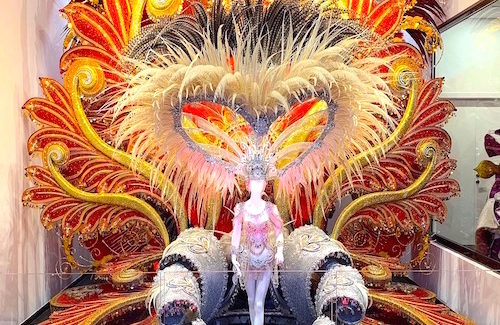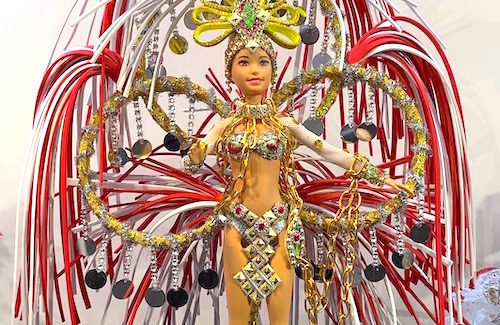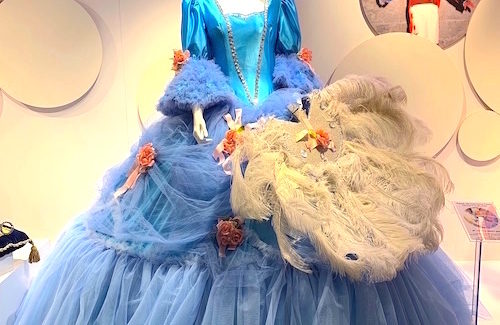Visiting Santa Cruz: Tenerife Port City Celebrates Extravagant Carnival
Streets are draped in mourning. Wailing “widows” in fishnet stockings and miniskirts lament loudly. Paraders dressed as popes, bishops and nuns bless onlookers and each other.
It’s “El Entierro de la Sardina” or the “Burial of the Sardine” in Santa Cruz de Tenerife, capital of the largest of the Canary Islands. It’s when a gigantic 30-foot papier mache fish is carried through city streets and thrown on a massive bonfire. As the huge fish goes up in flames, fireworks light the night to signal the official end of Carnival.
Of course, the partying does continue throughout the weekend. After all, this is the second most popular and internationally known carnival, after the one held in Rio de Janeiro, Brazil.
“We are very proud of our carnival,” said guide Miriam. “People come from many countries to see our carnival … It has been declared an International Tourist Attraction.”
A popular cruise ship stop, the port city welcomes visitors throughout the year but particularly during the annual Carnival.
This year the Santa Cruz Carnival runs from Sunday, Feb. 24, through Saturday, March 10. If you can’t make it for the actual celebration, Santa Cruz now has a new La Casa del Carnaval or Home of the Carnival opened in June 2017 to relive all the excitement and pageantry behind the ancient celebration.
“Everyone celebrates and dresses up in some kind of costume,” Miriam said, leading a tour through the La Casa del Carnaval museum. “Some people spend a lot of time and money on a costume. Some just use makeup and dress in what they have.”
2019 Theme is The Deep Sea
For 15 days, the streets of Santa Cruz burst with joy, beauty, color, freedom and extravagance. Every year a carnival theme is chosen by public voting.
“This year the theme will be ‘The Deep Sea,’ and we will have a special poster for that,” Miriam said, gesturing to a display of posters. Past themes have included “Odyssey in Space,” “Flower Power,” “The Future,” and “The World of Tales.”
The Santa Cruz carnival is split into two parts. The official carnival features more than 100 musical groups and scheduled events. The street carnival is where people just take to the streets and enjoy spontaneous carnival celebrations. The streets are filled with thousands of costumed people every day.
A museum display celebrates the 1987 Carnival when singer Celia Cruz and Billo’s Caracas Boys presented a concert. Attended by 250,000 people, the event was registered in the Guinness Book of Records as the largest gathering of people in an outdoor plaza to attend a concert.
A highlight of each Carnival is a carnival queen selected from several ages groups, including children, adults and seniors. “The queen costumes are very expensive and very heavy,” Miriam said.
Carnival queen candidates exercise extensively before the festivities so the winner can gracefully move while wearing one of the weighty gowns, Miriam added. One look at some of the extravagant heavy gowns on display does make it seem like no one person could possibly wear all that and still stand.
“The queen usually has to have someone help her get dressed because it is all too much,” Miriam said.
Wealth of Costumes Featured in New Museum
In addition to the many full-size costumes on display, the museum also features a timeline of tiny dolls dressed in costumes from years past. It is interesting to see how the dresses have become more ornate and elaborate over time.
Another exhibit showcases “Carnival Characters,” famous real-life people or cartoon or showbiz characters. Popular ones include Michael Jackson, Jack Sparrow, Popeye, Miss Piggy, Charlie Chaplin, Fidel Castro and Robocop.
A special room contains makeup, hats and costumes that visitors can try on for selfie photos. “This is where you do touch,” Miriam said.
The Santa Cruz Carnival dates from at least 1605 and probably earlier. The year 1605 is the first written record of the event. The Santa Cruz port was once the crossroads between Europe and the New World. Just about everyone heading to or from the Americas passed this way.
Some say that Carnival was brought to the island after the Spanish Conquest in 1492. Like most carnivals – including Mardi Gras in New Orleans – carnival is the last chance to feast and enjoy excess before Lent.
Even when dictators Miguel Primo de Rivera (1923-1935) and General Franco (1940-1960) ruled, the Carnival celebration continued under a different name – Winter Holiday – to avoid the ban placed against it.
Because of an almost perfect year-round climate, Santa Cruz is a city where people enjoy outdoor spaces like parks and plazas and look forward to the exciting activities and parades of the annual Carnival.
Although it may look casual, those who organize and participate in Tenerife’s Carnival take it very seriously. Some businesses cut back hours or close during the festivities. Dance troupes and musical groups spend months rehearsing. Colorful floats involve weeks of tedious work.
“And when one Carnival is over, people start planning what costumes they will create for the next one,” Miriam said. “It’s a very important time of year for us.”
Photos and story by Jackie Sheckler Finch

















View Recent Comments